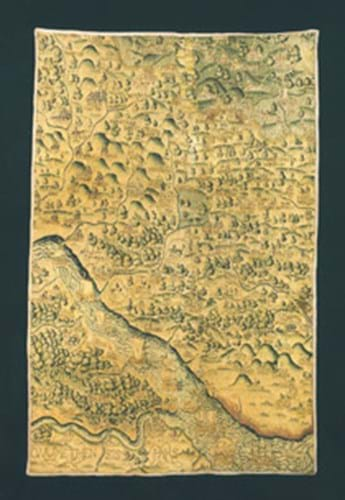
The 6ft 2in x 4ft (1.9m x 1.2m) wool and silk fragment constitutes a substantial portion of a tapestry of the Midlands and takes an eastward-looking perspective. It shows part of Monmouthshire, Gloucester-shire, Somerset and Avon, the Rivers Severn and Wye and the mouth of the Avon and the Forest of Dean.
It forms part of a series of four cartological tapestries commissioned by Ralph Sheldon (d.1613) from his own tapestry works for the dining room of his home, Weston House, which he built in 1588.
Sheldon is the man credited with introducing the technique of tapestry weaving to England and producing the earliest English tapestries.
He appointed a Fleming, Richard Hyckes, to manage his workshops and set them up to provide indigenously produced weavings for home consumption by wealthy customers who would otherwise have had to look overseas to acquire them. The enterprise prospered sufficiently for Sheldon to have acquired the title of Queen's Arras Maker by 1569.
Sheldon's cartological series represented the counties of Worcestershire, Oxfordshire, Gloucestershire and Warwickshire and was based on Christoper Saxton's Surveyes of the Counties of England of 1579.
At least one other series was produced in the mid 17th century for Ralph's great grandson, but of this original earliest quartet, the tapestries of Worcestershire and Oxfordshire are owned by the Bodleian Library and on view at the V&A.
Warwickshire is in the Warwick Museum, while four fragments have survived for Gloucestershire, one of which was the piece offered at Christie's.
Most of the history of Christie's fragment can be traced back via a long and detailed provenance. The fragment remained at Weston House until 1781 when Christie's sold the contents at auction. It then appears in a curiosity shop in Davies Street London in 1864-5, and was acquired a decade later by the brothers Robert and Henry Birkbeck of Westacre, Swaffham, Norfolk, the contents of which were sold by Sotheby's in 1920. Thence acquired by Sir Philip Sassoon and Viscount Ednam, it next appeared in
the Vigo-Sternberg Galleries in South Audley Street in 1971. It was then purchased by Captain Edward Guinness, whose wife's maiden name was Sheldon, and thence passed to the vendor by direct descent.
With so many of the other elements from this set in institutions, the chance to purchase such a key piece of early English tapestry was not likely to arise again soon.
Clearly there were enough bidders who appreciated the scarcity of the opportunity and the historical significance to take the price to £78,000 (plus premium).
But this piece, too, will now be off the market having been secured by the Bodleian. Having been alerted to the impending sale by one of their researchers, the library quickly arranged to obtain the necessary funding to make the purchase.
The Art Fund provided £47,375 towards the total cost of just over £100,000, with additional funds from the John R. Murray Charitable Trust, the Library's support group, the Friends of the Bodleian, and a number of private donors.
The Library's acquisition of the Gloucestershire tapestry will make it possible to reunite this substantial portion of the fourth map with the two from the original set which it already owns. It is considered an important addition to the Library's existing holdings of Tudor cartography.
"The stunningly beautiful map depicts the late 16th century Gloucestershire landscape with remarkable clarity and precision and the prospect of displaying such a striking artefact at the Bodleian is tremendously exciting, especially as it will now be housed only 26 miles from where it was created," said the Bodleian's map librarian, Nick Millea.
By Anne Crane




